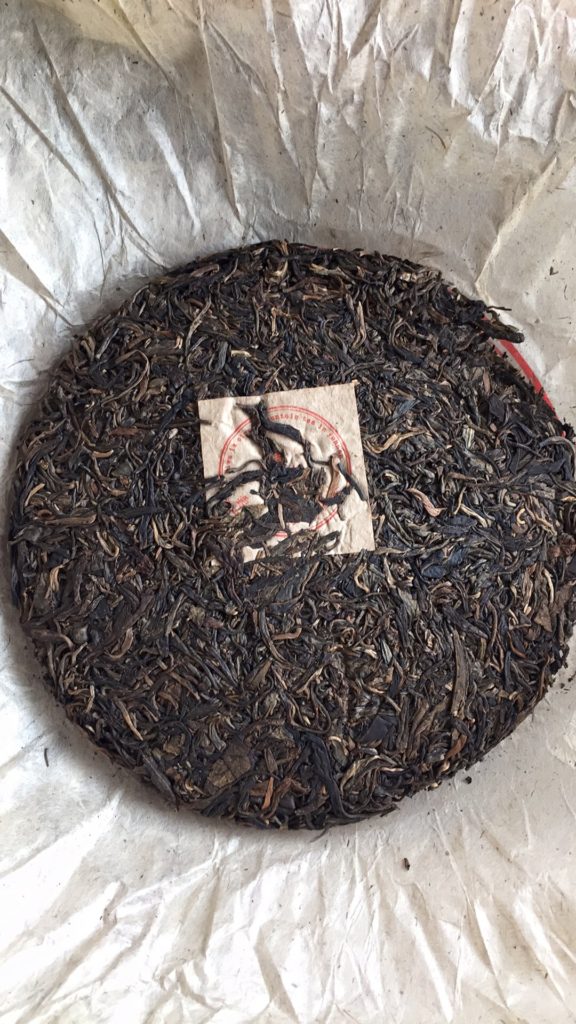Every so often I buy some tea from Taobao. Sometimes it’s a cake I already know and like and am just stocking up a little more. More often it’s something random – given that there’s MiniN and MicroN in the picture, my days of roaming the tea market for days on end is more or less over (at least for now). So, instead, I get to virtually shop online through the wonder that is Taobao, where Jack Ma claims the fake goods are better than the real deal.
Well, here’s a fake that isn’t better than the real deal. The reason I bought this cake is because the wrapper suggests that this may be related to a small boutique whose tea I have some faint interest in, and that this tea is sold as a 2003 tea. Given the lowish price (under 100 RMB) I figured I can buy a lottery ticket. Worst case, it’s just a bad tea and I chalk it up to eating a bad meal somewhere, or something. The cake looks ok-ish in person
The smell though put me off. When I smelled the tea after it arrived it smelled like cooked puerh, which is odd, since this is supposed to be a raw tea. There was no hint of rawness in the smell – none of that sweet aroma of aging tea, or the youthful greenness that you get with a younger tea (as befits a Kunming stored puerh). Instead, just a faint whiff of cooked puerh. I chalked it up to potentially the couple bags of cooked puerh samples the seller threw in with the cake.
There are some oddities on the cake itself – hard to see with any kind of picture but apparent if you examine it in detail. There are some leaves that look funny, with little white dots that are uncharacteristic of dry Kunming storage. But, that alone isn’t going to be enough to warn anyone.
Then I brewed it, and that’s when everything became really obvious. The tea is actually a mix – a mix of raw and cooked leaves, to be exact. The tea brews brown, like a cooked tea, and smells of cooked puerh. There’s no hint of rawness in the tea. The wet leaves look like this
You can see that there’s a mix here – the cooked tea is the dark stuff, and this is the variety that is very cooked – they’re carbonized, hard leaves that don’t really bend, not the soft stuff you might see from Menghai. In other words, this is cheap stuff. The raw tea is probably worse – I suspect it is brewed tea leaves that are then dried again, because if they were using new leaves there’s no way that the tea doesn’t impart any taste, but as it is there’s almost no raw, new tea taste to it despite the tea consisting of mostly raw leaves. I only took a couple small sips before dumping the whole lot.
What’s the lesson here? Well, anything is possible, even stuff you thought impossible. Judge a tea on its own merits and not on what the vendor is telling you, and sometimes the truth is pretty disgusting. And Jack Ma is wrong at least when it comes to tea – the vast majority of the fakes are horrible things that should never be drunk.




3 responses so far ↓
Tiago // June 15, 2016 at 8:24 am |
That’s terrible. I really hope you left a bad review of the seller.
Serg // June 16, 2016 at 4:56 am |
This is unbelievable. To mix shu with brewed and re-dried sheng and sell it as a semi-aged sheng… And it looks decent on photos! Good job, fake sellers! Seriously though, I can imagine how disappointig this is. I recently bought some dian hong from a seller on aliexpress in 100g bag. The point is that I had this tea before in 50g bag from this same seller. And the new tea was absolutely different tea and probably even scented. I really decided to never ever again buy tea from such sites and sellers. And your story makes me feel that’s the right thing to do. After all there are many good trusty sellers on the net which need tea fans to support their small bussiness.
MarshalN // June 16, 2016 at 8:56 am |
I can’t be 100% certain it’s all re-dried sheng, but there’s a high likelihood that there’s some in there. Otherwise I cannot explain how so much leaves can have so little taste – even the crappiest summer tea will have more flavour than what I detected.